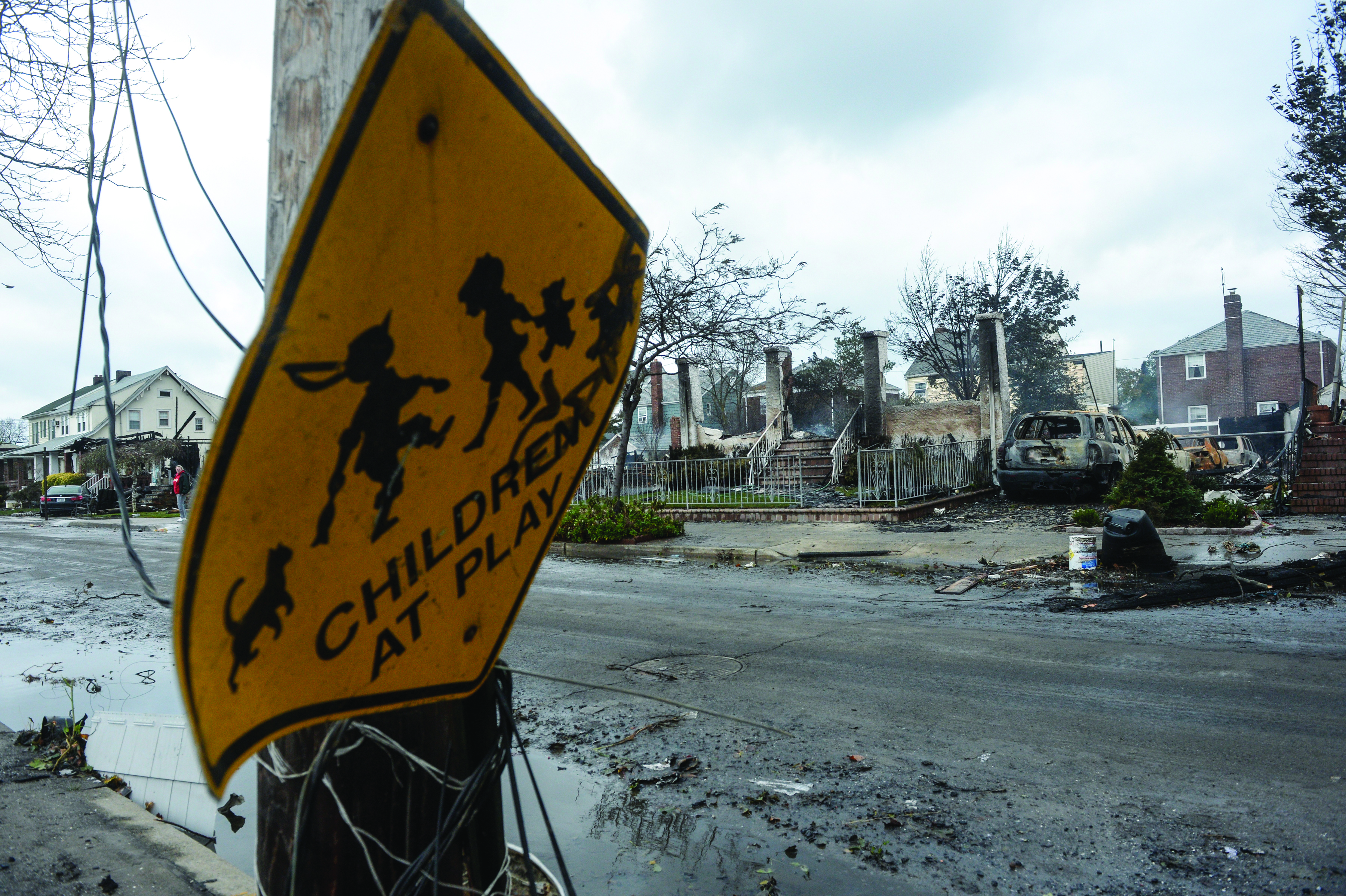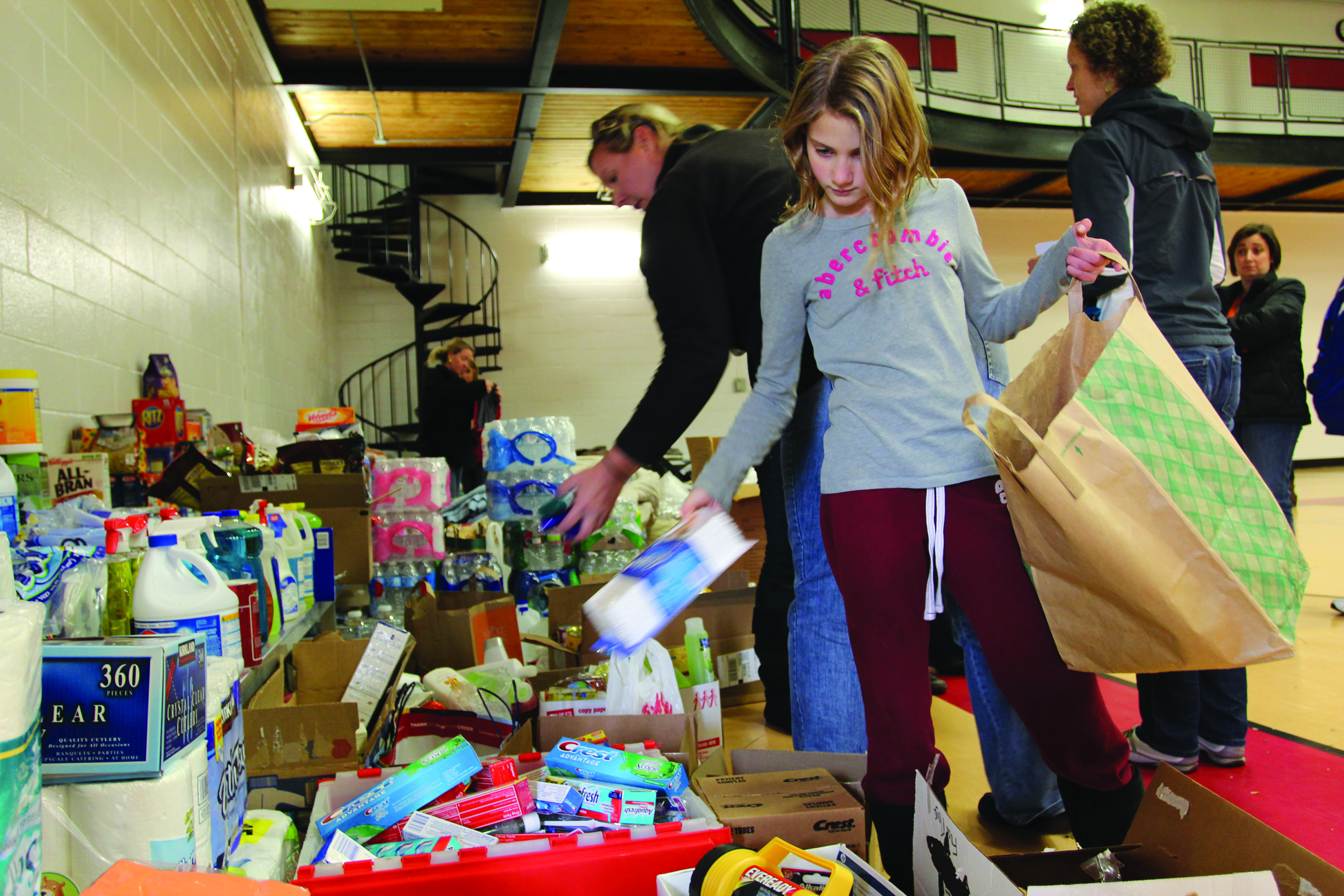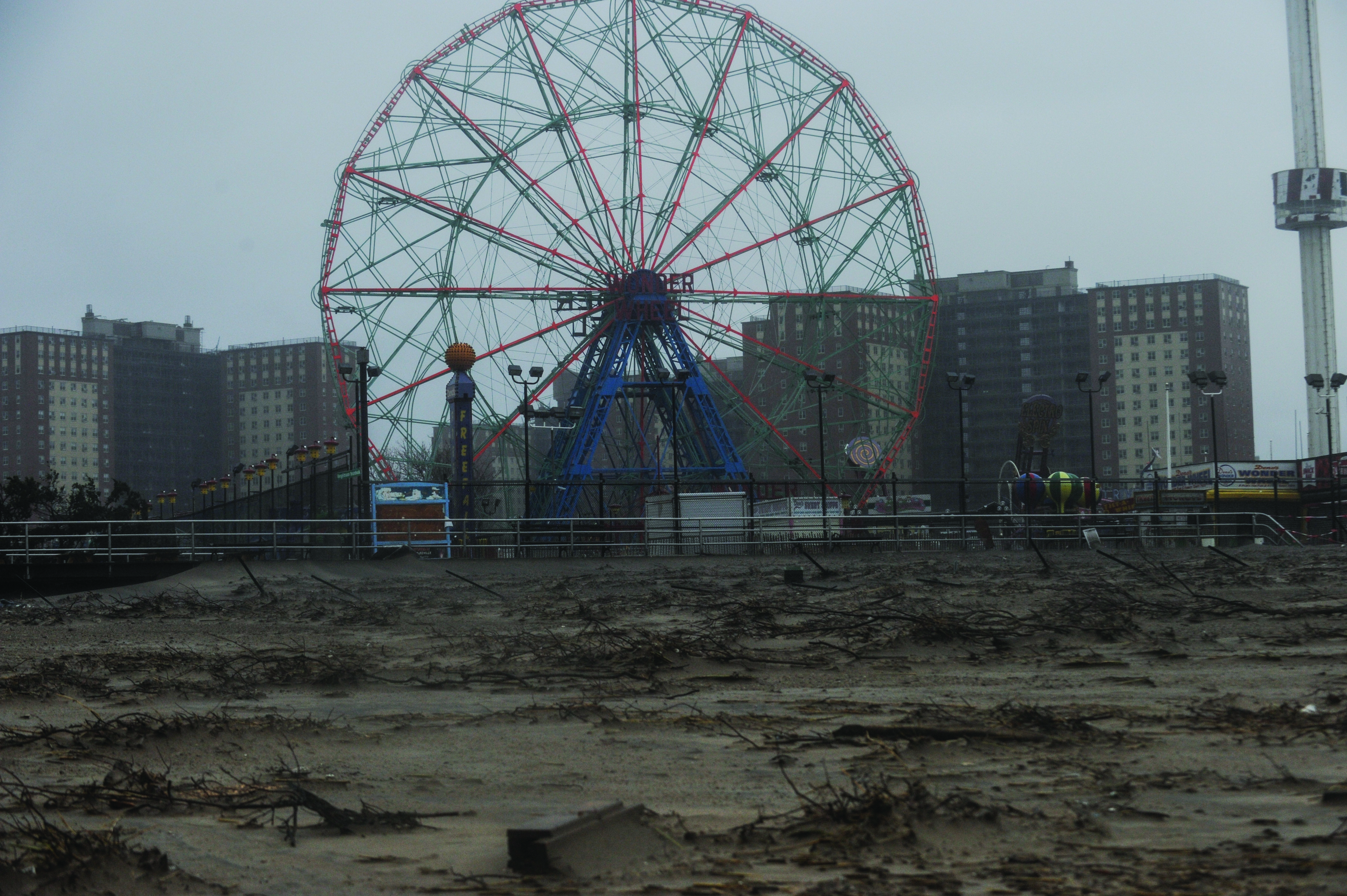Agencies hit by Hurricane Sandy and other disasters recount road to rebuilding
Located virtually harbor-side in southwest Brooklyn, the Red Hook Community Justice Center faced a daunting set of challenges in the days and weeks after Hurricane Sandy last October.
Red Hook’s entire youth programming space and computer lab were destroyed as 5 feet of water came gushing through the basement of the Center for Court Innovation, where the agency is housed, a public/private partnership between the New York State Unified Court System and the Fund for the City of New York.
Red Hook was just one of many agencies displaced or impacted by the storm. It is unclear just how many – the Red Cross didn’t have updated statistics, and FEMA did not have this information. And its experiences, among others’, illustrate how youth organizations and other social services providers have to figure out how to manage after a natural disaster – and how others can be prepared to do so, in advance.
The court system and city have helped with Red Hook’s rebuilding — city agencies are also co-located in the Center for Court Innovation’s basement — and Red Hook has tapped into both its own insurance and FEMA funds, according to Jessica Colon, deputy project director, who did not yet have a figure for the damage. Happily, the renovation proceeded more quickly than expected, and, while in the midst of buying new furniture, cubicle walls, computers and other equipment in late December, Colon anticipated youth programming would be back to normal in early 2013.
But in the days and weeks immediately after the disaster, Red Hook faced problems common to youth agencies whose physical structures or surrounding communities have been hammered by hurricanes, tornadoes or other natural disasters: where they could possibly provide programming as structures were rebuilt, or serve larger numbers than usual; and how they could best reach out and meet youth’s needs while simultaneously facing their own rebuilding challenges.
Colon says Red Hook reached out immediately to FEMA, the National Guard, the Red Cross, public housing facilities and other local partners to determine what needs existed, how they could help, and where to get help for themselves. While Red Hook had established plans in place for shutdowns lasting hours or a few months, the unprecedented nature of Sandy meant that the agency did not have a protocol for one that would last indefinitely—and one in which mass transit was shut down and those staff who had cars had few prospects of finding gasoline to fill them.
Red Hook’s restorative justice programming provided through the courts—alternative sanctions like anger management or marijuana awareness sessions—shut down until courts reopened. Red Hook moved its youth court, where teens hear about 160 to 170 cases per year referred by the New York Police Department around issues like truancy and delinquent behavior, to the local 76th Precinct building.
And Red Hook found spots for after-school programming as well, Colon said: The drawing program operated out of a local art gallery, and the chess program continued at South Brooklyn High School. “We wanted to make sure [the students’ lives weren’t] completely interrupted by this storm,” she says. “To be able to provide this consistency was so important for us. They know where they’ll be. Their parents know where they’ll be.”
That required an expanded definition of one’s office and the use of what modern technology still remained available to staff, Colon says. “For the first week and a half, we were operating out of a local park … on our Blackberries.” But she adds, “There was an outpouring of support at all levels,” Colon said. “We were reaching out; people were contacting us. The biggest assistance, with the physical building, we were reaching out to the city and court system. There was definitely an outpouring of, ‘Do you guys need help?’ ”
Going forward, Colon envisions a “long-term broader conversation” among government leaders at all levels on how to protect coastal areas against the ravages of such storms. “This storm was a huge wake-up call with the city, realizing just how vulnerable we are,” she said. “Coastal communities, a place like Red Hook, feel separate. There’s a sense of living on the edge. The Rockaways, parts of Staten Island, they’re tough people. A storm? Whatever. Another flood? It happens every few years. But this was a wake-up call.”
Emergency pizza
Hurricane Sandy hit New Alternatives, a program based in New York City’s East Village that serves homeless LGBT youth, with a weeklong outage that caused several thousand dollars worth of food in its 6-foot freezers to spoil.
The agency, which generally spends about $250 per week to feed 50 people, took a significant hit on its $125,000 total budget, ameliorated somewhat by cash donations from the Stonewall Foundation and in-kind contributions from the Food Bank of New York City and the Red Cross, says Kate Barnhart, founder and director of New Alternatives.
But LGBT young people ages 18 to 24 were looking for a meal before those arrangements were made, which necessitated a massive pizza order the Sunday right after Sandy hit, says Barnhart, who hopes the church building in which they’re housed decides to purchase a generator for future blackouts. “The budget’s been stretched thin, but we’ve kept feeding people,” she says.
The agency also connected regular attendees with hurricane relief shelters and helped them push past fears that those shelters “were for quote-unquote ‘regular’ people,” she adds. “They felt the shelters wouldn’t be welcoming to people who were chronically homeless.” In fact, the shelters were perfectly welcoming.
Agencies whose own backyards were not as pummeled stepped up to help meet the needs of youth and families. The 41 YMCA branches throughout New Jersey felt the impact of Hurricane Sandy with loss of power, but as power came back on, they served storm victims in a number of ways, including provision of child care, says Bill Lovett, executive director of the New Jersey Alliance for YMCAs.
Y’s served as emergency shelter, providing services from free showers to cell-phone recharging at a time when hot-water heaters and landlines were also on the fritz. As parents tried to return to work but some schools stayed closed, branches also added emergency child-care to their menu of impromptu offerings, Lovett says.
“They had some schools with power, so they doubled up on some and got reopened after about a week,” he says. Until they did, “parents needed child care, people needed to go back to work, there were childcare centers without power. It was all hell breaking loose.”
New Jersey Y’s did not have a plan in place for how to respond to a natural disaster but branches independently made many of the same decisions, Lovett says. Given that 80 percent of the state’s residents live within five miles of a Y, “We had the scale and breadth to be able to do something with a fairly effective impact,” he says.
Planned at Hurricane Central
Located in a part of the country that’s a little more accustomed to hurricanes, the Tampa Metropolitan YMCA—which has 18 facilities, four of them located in flood zones—has a fleshed-out crisis management plan in place, says Joe Mangione, associate vice president of risk management and property. (See sidebar for basic components of an emergency plan.)
The Tampa Y has relationships with three property response and restoration companies to repair damage to any Y properties, and Mangione’s department conducts annual building inspections to ensure that air-conditioner units, roofs, foundations and swimming pool areas (including loose furniture) are as watertight and well-secured as possible, he says.
To date, the Tampa Y’s facilities have been spared the brunt of major storms, but when three separate storms pounded the region in 2005, the Y branches were ready to either expand their after-school programs or summer camp locations to provide needed child care, Mangione says.
Last summer, a power outage unrelated to a storm required a day-trip for kids at one facility to one of the overnight camps. “It was a little bit of a headache, but the kids had a great time,” he says. “We’re flexible. If one facility cannot support any more children, we have another facility that can.”
Twin Cities tornadoes
Tornadoes can wreak similar if not worse destruction than hurricanes as they touch down, although their impact is somewhat more random—one block is left standing completely intact while another is razed to the ground.
Youth-serving agencies in both Minneapolis and Joplin, Mo., needed to help prop up both the infrastructure of their communities and the spirits of local youth in the aftermath of 2011 tornadoes—assisting displaced families, extending youth programming, and providing kids a chance to express emotions and fears.
When tornadoes touched down in May 2011, the Minneapolis Beacons Network, which serves about 3,300 young people per year, turned first to ensuring families displaced by either structural damage to their dwellings or loss of power were relocated, safe and had provisions.
“But then, our lens turned to, ‘What is going to happen with these young people, knowing how much stress their parents were under?’ ” says Jenny Wright Collins, program director for the network, a provider of after-school and summer programs in partnership with the YMCA, YWCA, Boys and Girls Clubs and Minneapolis Public Schools. “We did some reflecting, did some art projects, had our young people come up with a service project so they could feel a little bit like they had their power back—and to give them a safe space to acknowledge those feelings.”
Minneapolis Beacons played matchmaker between those who needed emergency childcare and agencies able to provide it, Wright Collins says. “We already had trust in place and when the crisis hit, we were able to respond,” she says. “The school district calls me, I call the Boys and Girls Club, and boom, within six hours we had youth workers in place. It provided a sense of normalcy and security.”
The network received $35,000 administered through the Minneapolis Foundation as part of an effort coordinated by the United Way called Minnesota Helps, which expanded youth enrichment programming during August at four locations. “Summer school ends, parks aren’t as available, youth programs tend to take a break,” and yet some families were still not back in their homes, Wright Collins says.
Elsewhere in Minneapolis, the Plymouth Christian Youth Center also received a $35,000 grant from the Minneapolis Foundation to expand its work with students who attend its alternative school or after-school programming, more than half of whose homes were affected, says Anne Long, executive director of PCYC.
Although homes directly across the street from Plymouth Christian were badly damaged, the agency’s glass-enclosed frontage was spared a major catastrophe—although the building did sustain $50,000 to $75,000 in damage to the roof-mounted air-conditioning system, portions of the roof itself, the building’s alarm system and other “odd little things,” most of which insurance covered, Long says.
Plymouth Christian provided counselors at the alternative school immediately after the May event, despite the fact that power was out and school not in session because “our high school kids kept trying to come to school,” she says. “The minute that electricity came back on, school started again,we had our full staff. … Social workers made sure they made contact with every student and listened to their story,” and that storytelling became a component of after-school programming, as well.
The $35,000 grant went to PCYC’s summer program, which was able to add a youth development teacher and thus an additional 15 students, Long says. “The notion of getting back to regularity and at the same time, having the adults around them who recognized the signs of trauma, and who are there to stop, and listen and offer support is really important,” she says. “The kids continue to worry about tornadoes. It’s an ongoing, life-affecting event.”
Playing in the rubble
Juan “Cookie” Estrada, CEO of the YMCA in Joplin, Mo., can testify to that. Although the May 2011 tornado that devastated entire communities swept directly between that town’s two Y facilities, Estrada and his staff had plenty of work to do in responding to community members’ needs.
Estrada had an epiphany when he saw a father standing amidst what had been his home, with his children at his feet playing in the rubble. “I realized children needed to be in a safer environment as their families tried to get their belongings and their lives back together,” he says. “If the parents needed to find their belongings, get their wits wherever they needed to be, shower, whatever, we took care of children from infant to whatever age. We were flooded with children.”
With a $100,000 gift from the Home Depot Foundation and smaller contributions from others, the Y opened and staffed six sites around the city and stocked them with activities and events, partnering with some of the town’s 13 child-care facilities that had been wiped out by the storm, Estrada says. “We had those children placed somewhere,” he says.
The Y helped in other unexpected ways; for example, a hospital two blocks away from one of the branches was destroyed, so the Y’s parking lot ended up being used for healthcare triage. “This was unreal, something you would see on war movies, with destruction from bombs,” Estrada says. “Mother Nature has her way. You cover yourself the best you possibly can for the environment you’re in. If I could predict [when the next storm would hit], I wouldn’t be sitting in the position I’m in now. Only the good Lord knows that.”
Ed Finkel is a writer, editor and Web content manager with 20 years of professional experience.



























